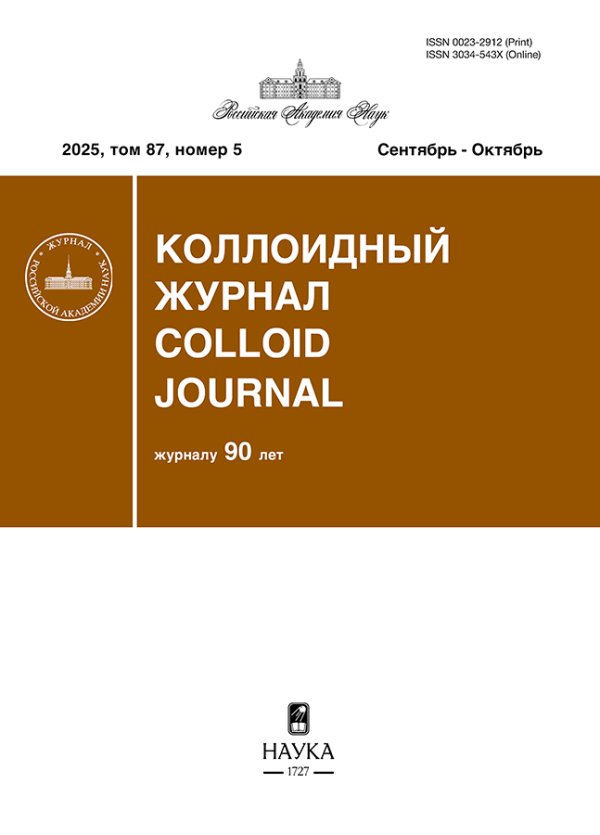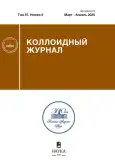STUDY OF MECHANISM OF STRUCTURE FORMATION IN AQUEOUS DISPERSIONS OF NA+-SMECTITES
- Authors: Pokidko B.V.1, Dulina O.A.2
-
Affiliations:
- Institute of Geology of Ore Deposits, Petrography, Mineralogy, and Geochemistry of the Russian Academy of Sciences
- MIREA – Russian Technological University, Department of Nanoscale Systems and Surface Phenomena
- Issue: Vol 87, No 2 (2025)
- Pages: 128-141
- Section: Articles
- Submitted: 18.08.2025
- Published: 15.03.2025
- URL: https://journals.rcsi.science/0023-2912/article/view/304831
- DOI: https://doi.org/10.31857/S0023291225020054
- EDN: https://elibrary.ru/tpbvdj
- ID: 304831
Cite item
Abstract
Present paper contains the results of an experimental study of the colloidal structures and rheology of aqueous dispersions of Na+-montmorillonite, which were obtained by capillary and rotational viscometry methods. Aqueous dispersions of clay colloids undergo significant structural changes, accompanied by great change in the type of the flow. All these changes are managed by alteration in indifferent electrolyte concentration within a narrow concentration range. Certain critical concentration was found to appear near about 3 mM NaCl concentration for the series of dispersions with 0.25–3.0 wt% solid content. This concentration point is significantly lower than the coagulation thresholds known from the experimental and theoretical works in this field. Existence of such a critical region may reflects both processes of formation/disruption of aggregates and change in the mechanism of either aggregation or structure formation. The obtained rheological data were compared with theoretical calculations and the results of dispersion analysis (by DLS method) of aqueous dispersions which might make a bit development in the field of colloid structure investigation of smectite dispersions.
Keywords
About the authors
B. V. Pokidko
Institute of Geology of Ore Deposits, Petrography, Mineralogy, and Geochemistry of the Russian Academy of Sciences
Email: pokidko2000@mail.ru
35 Staromonetny Lane, Moscow, 119017 Russia
O. A. Dulina
MIREA – Russian Technological University, Department of Nanoscale Systems and Surface Phenomena
Author for correspondence.
Email: pokidko2000@mail.ru
78 Vernadsky Ave., Moscow, 119484 Russia
References
- Van Olphen H. An Introduction to Clay Colloid Chemistry. 1963. NY and London: Wiley, 1963.
- Осипов В.И., Соколов В.Н. Глины и их свойства. Состав, строение и формирование свойств. М.: ГЕОС. 2013. С. 576.
- Handbook of clay science. Sec. ed. Part A. Fundamentals. Edited by F.Bergaya and G. Lagaly. Oxford, UK: Elsevier. 2006. Ch.8 (Colloid clay science. ed. by G.Lagaly, I.Dekany, pp. 243–346), p. 1246, ISBN: 0080441831.
- Bailey L., Lekkerkerker H.N.W., Maitland J.C. Smectite clay – inorganic particle mixed suspensions. Phase behavior and rheology // Soft Matter. 2015. V. 11. № 2. P. 222–236. https://doi.org/10.1039/c4sm01717j
- Norrish K. The swelling of montmorillonite // Discussions of the Faraday Society. 1954. V. 18. P. 120. https://doi.org/10.1039/c4sm01717j 134. https://doi.org/10.1039/df9541800120
- Michot L.J., Bihannic I., Porsch K. Phase diagrams of Wyoming Na-montmorillonite clay. Influence of particle anisotropy // Langmuir. 2004. V. 20. № 25. P. 10829–10837. https://doi.org/10.1021/la0489108
- Abend S., Lagaly G. Sol–gel transitions of sodium montmorillonite dispersions // Applied clay science. 2000. V. 16. № 3–4. P. 201–227 https://doi.org/10.1016/s0169-1317(99)00040-x
- Pilavtepe M., Delavernhe L., Steudel A. et al. Formation of arrested states in natural di- and trioctahedral smectite dispersions compared to those in synthetic hectorite – a macro- and microrheological study // Clays and clay minerals. 2018. V. 66. № 4. P. 339–352. https://doi.org/10.1346/CCMN.2018.064102
- Kimura H., Okubo T. Rheological properties of sodium montmorillonite in exhaustively deionized dispersions and in the presence of sodium chloride // Colloid and polymer science. 2002. V. 280. № 6. P. 579–583. https://doi.org/10.1007/s00396-001-0647-y
- Shoaib M., Khan S., Wani O.B., Adala A., Seiphoori A., Bobicki E.R. Modulation of soft glassy dynamics in aqueous suspensions of an anisotropic charged swelling clay through pH adjustment // Journal of colloid and interface science. 2022. V. 606. № 1. P. 860–872. https://doi.org/10.1016/j.jcis.2021.08.034
- Pecini E.M.; Avena M.J. Measuring the isoelectric point of the edges of clay mineral particles: The case of montmorillonite // Langmuir. 2013. V. 29. № 48. P. 14926–14934. https://doi.org/10.1021/la403384g
- Secor R.B., Radke C.J. Spillover of the diffuse double layer on montmorillonite particles // Journal of colloid and interface science. 1985. V. 103. № 1. P. 237–244. https://doi.org/10.1016/0021-9797(85)90096-7
- Tombacz E., Szekeres M. Colloidal behavior of aqueous montmorillonite suspensions: the specific role of pH in the presence of indifferent electrolytes // Applied clay science. 2004. V. 27. № 1–2. P. 75–94. https://doi.org/10.1016/j.clay.2004.01.001
- Miller S.E., Low P.F. Characterization of electrical double layer of montmorillonite // Langmuir. 1990. V. 6. № 3. P. 572–578. https://doi.org/10.1021/la00093a010
- Chen J.S., Cushman J.H., Low P.E. Rheological behavior of Na-montmorillonite suspensions at low electrolyte concentrations // Clays and clay minerals. 1990. V. 38. № 1. P. 57–62. https://doi.org/10.1346/ccmn.1990.0380108
- Lagaly G., Ziesmer S. Colloid chemistry of clay min erals: the coagulation of montmorillonite dispersion // Advances in colloid and interface science. 2003. V. 100–102. P. 105–128. https://doi.org/10.1016/S0001-8686(02)00064-7
- Kaufhold S., Kaufhold A., Dohrmann R. Comparison of the critical coagulation concentrations of allophane and smectite // Colloids and interfaces. 2018. V. 2. № 1. P. 1–14. https://doi.org/10.3390/colloids2010012
- Jackson, M.L. Soil Chemical Analysis: Advanced Course; UW-Madison Libraries parallel press, 2005; ISBN 1-893311-47-3.
- Koroleva T., Krupskaya V., Tyupina E., Morozov I., Kozlov P., Pokidko B., Zakusin S., Zaitseva T. Impacts of impurity removal chemical pretreatment procedures on the composition and adsorption properties of bentonites // Minerals. 2024. V. 14. № 8. P. 1–14. https://doi.org/10.3390/min14080736
- Покидько Б.В., Крупская В.В., Белоусов П.Е., Закусин С.В. Методика измерения емкости катонного обмена по адсорбции комплекса меди (II) с триэтилентетрамином – Cu-trien. ФБУ Ростест-Москва, Свидетельство об аттестации №АВ 0003160, метод № 1002/03 RA.RU. 311703-2022.
- Глины формовочные бентонитовые. ГОСТ 28177-89.
- Покидько Б.В. Экспериментальные методы точной оценки состава обменного комплекса смектитов и бентонитовых глин. Материалы VII Российской школы по глинистым минералам «Argilla Studium-2022», Москва: ИГЕМ РАН. 2022. C. 32–34.
- Kaufhold S, Dohrmann R., Stucki J.W., Anastacio A.S. Layered charge density of smectites – closing the gap between the structural formula method and the alkyl ammonium method // Clays and clay minerals. 2011. V. 59. № 2. P. 200–211. https://doi.org/10.1346/CCMN.2011.0590208
- Tsipursky S.J., Eisenhour D.D., Beall G.W. at al. Method of determining the composition of clay deposit. United state patent 6235533, 2001. AMCOL Int Corp. G01N 33/00
- Weber Ch., Kaufhold S. Hamaker functions for kaolinite and montmorillonite // Colloid and interface science communications. 2021. V. 43. P. 100442. https://doi.org/10.1016/j.colcom.2021.100442
- Segad M., Jonsson Bo., Akesson T., Cabane B. Ca/Na montmorillonite: structure, forces and swelling properties // Langmur. 2010. V. 26. №. 8. P. 5782–5790. https://doi.org/10.1021/la9036293
- Baravian C., Vantelon D., Yhomas F. Rheological determination of interaction potential energy for aqueous clay suspensions // Langmuir. 2003. V. 19. № 19. P. 8109–8114. https://doi.org/10.1021/la034169c
- Kaufhold S., Dohrmann R., Koch D., Houben G. The pH of aqueous bentonite suspensions // Clays and Clay Minerals. 2008. V. 56. № 3. P. 338–343. https://doi.org/10.1346/CCMN.2008.0560304
- Holmboe M., Wold S., Jonsson M. Porosity investigation of compacted bentonite using XRD profile modeling // Journal of contaminant hydrology. 2012. V. 128. № 1–4. P. 19–32. https://doi.org/10.1016/j.jconhyd.2011.10.005
Supplementary files










